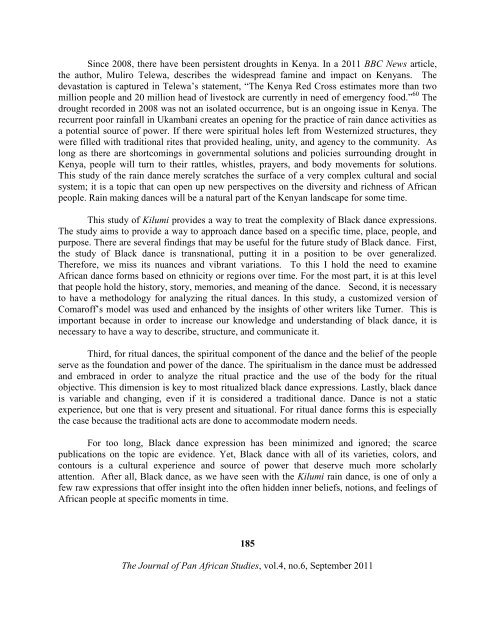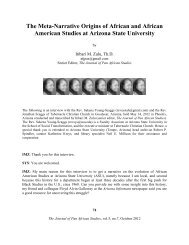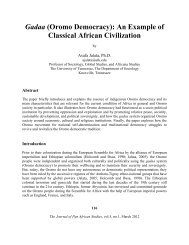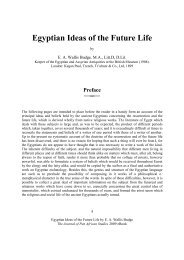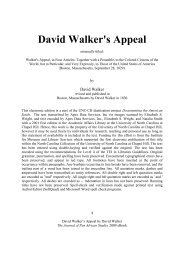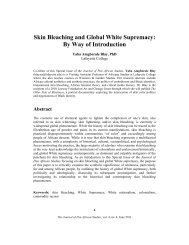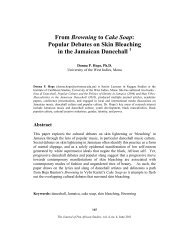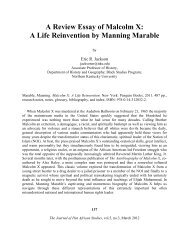The Kilumi Rain Dance in Modern Kenya - Journal of Pan African ...
The Kilumi Rain Dance in Modern Kenya - Journal of Pan African ...
The Kilumi Rain Dance in Modern Kenya - Journal of Pan African ...
You also want an ePaper? Increase the reach of your titles
YUMPU automatically turns print PDFs into web optimized ePapers that Google loves.
S<strong>in</strong>ce 2008, there have been persistent droughts <strong>in</strong> <strong>Kenya</strong>. In a 2011 BBC News article,<br />
the author, Muliro Telewa, describes the widespread fam<strong>in</strong>e and impact on <strong>Kenya</strong>ns. <strong>The</strong><br />
devastation is captured <strong>in</strong> Telewa’s statement, “<strong>The</strong> <strong>Kenya</strong> Red Cross estimates more than two<br />
million people and 20 million head <strong>of</strong> livestock are currently <strong>in</strong> need <strong>of</strong> emergency food.” 60 <strong>The</strong><br />
drought recorded <strong>in</strong> 2008 was not an isolated occurrence, but is an ongo<strong>in</strong>g issue <strong>in</strong> <strong>Kenya</strong>. <strong>The</strong><br />
recurrent poor ra<strong>in</strong>fall <strong>in</strong> Ukambani creates an open<strong>in</strong>g for the practice <strong>of</strong> ra<strong>in</strong> dance activities as<br />
a potential source <strong>of</strong> power. If there were spiritual holes left from Westernized structures, they<br />
were filled with traditional rites that provided heal<strong>in</strong>g, unity, and agency to the community. As<br />
long as there are shortcom<strong>in</strong>gs <strong>in</strong> governmental solutions and policies surround<strong>in</strong>g drought <strong>in</strong><br />
<strong>Kenya</strong>, people will turn to their rattles, whistles, prayers, and body movements for solutions.<br />
This study <strong>of</strong> the ra<strong>in</strong> dance merely scratches the surface <strong>of</strong> a very complex cultural and social<br />
system; it is a topic that can open up new perspectives on the diversity and richness <strong>of</strong> <strong>African</strong><br />
people. <strong>Ra<strong>in</strong></strong> mak<strong>in</strong>g dances will be a natural part <strong>of</strong> the <strong>Kenya</strong>n landscape for some time.<br />
This study <strong>of</strong> <strong>Kilumi</strong> provides a way to treat the complexity <strong>of</strong> Black dance expressions.<br />
<strong>The</strong> study aims to provide a way to approach dance based on a specific time, place, people, and<br />
purpose. <strong>The</strong>re are several f<strong>in</strong>d<strong>in</strong>gs that may be useful for the future study <strong>of</strong> Black dance. First,<br />
the study <strong>of</strong> Black dance is transnational, putt<strong>in</strong>g it <strong>in</strong> a position to be over generalized.<br />
<strong>The</strong>refore, we miss its nuances and vibrant variations. To this I hold the need to exam<strong>in</strong>e<br />
<strong>African</strong> dance forms based on ethnicity or regions over time. For the most part, it is at this level<br />
that people hold the history, story, memories, and mean<strong>in</strong>g <strong>of</strong> the dance. Second, it is necessary<br />
to have a methodology for analyz<strong>in</strong>g the ritual dances. In this study, a customized version <strong>of</strong><br />
Comar<strong>of</strong>f’s model was used and enhanced by the <strong>in</strong>sights <strong>of</strong> other writers like Turner. This is<br />
important because <strong>in</strong> order to <strong>in</strong>crease our knowledge and understand<strong>in</strong>g <strong>of</strong> black dance, it is<br />
necessary to have a way to describe, structure, and communicate it.<br />
Third, for ritual dances, the spiritual component <strong>of</strong> the dance and the belief <strong>of</strong> the people<br />
serve as the foundation and power <strong>of</strong> the dance. <strong>The</strong> spiritualism <strong>in</strong> the dance must be addressed<br />
and embraced <strong>in</strong> order to analyze the ritual practice and the use <strong>of</strong> the body for the ritual<br />
objective. This dimension is key to most ritualized black dance expressions. Lastly, black dance<br />
is variable and chang<strong>in</strong>g, even if it is considered a traditional dance. <strong>Dance</strong> is not a static<br />
experience, but one that is very present and situational. For ritual dance forms this is especially<br />
the case because the traditional acts are done to accommodate modern needs.<br />
For too long, Black dance expression has been m<strong>in</strong>imized and ignored; the scarce<br />
publications on the topic are evidence. Yet, Black dance with all <strong>of</strong> its varieties, colors, and<br />
contours is a cultural experience and source <strong>of</strong> power that deserve much more scholarly<br />
attention. After all, Black dance, as we have seen with the <strong>Kilumi</strong> ra<strong>in</strong> dance, is one <strong>of</strong> only a<br />
few raw expressions that <strong>of</strong>fer <strong>in</strong>sight <strong>in</strong>to the <strong>of</strong>ten hidden <strong>in</strong>ner beliefs, notions, and feel<strong>in</strong>gs <strong>of</strong><br />
<strong>African</strong> people at specific moments <strong>in</strong> time.<br />
185<br />
<strong>The</strong> <strong>Journal</strong> <strong>of</strong> <strong>Pan</strong> <strong>African</strong> Studies, vol.4, no.6, September 2011


